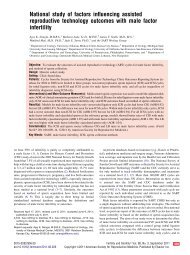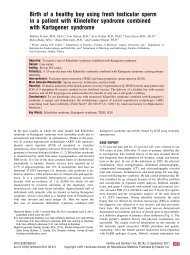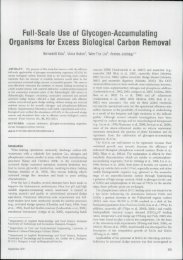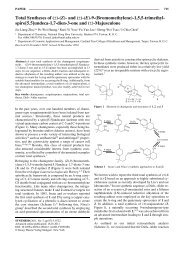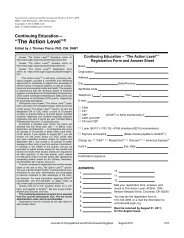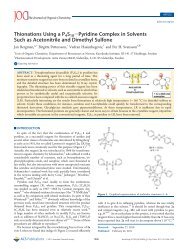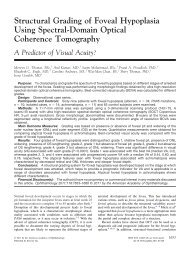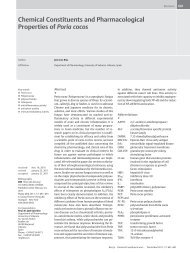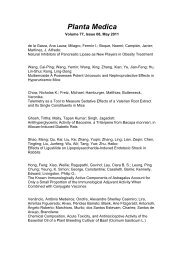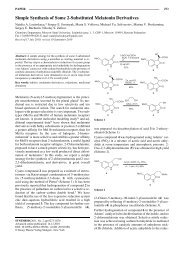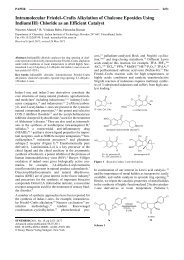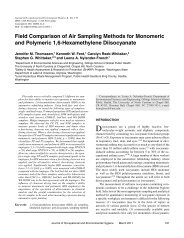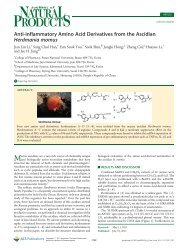Effects of Herbal Supplements on Drug Glucuronidation. Review of ...
Effects of Herbal Supplements on Drug Glucuronidation. Review of ...
Effects of Herbal Supplements on Drug Glucuronidation. Review of ...
Create successful ePaper yourself
Turn your PDF publications into a flip-book with our unique Google optimized e-Paper software.
318<br />
<strong>Review</strong>s<br />
St. Johnʼswort<br />
St. Johnʼswort(Hypericum perforatum) extract is used for insomnia<br />
and depressi<strong>on</strong> [113]. Flav<strong>on</strong>ol glycosides are the major class<br />
<str<strong>on</strong>g>of</str<strong>on</strong>g> compounds found in St. Johnʼs wort extract, with rutin, hyperoside,<br />
isoquercitrin, quercitrin (quercetin 3-rhamnoside),<br />
and miquelianin being the main compounds. Other comp<strong>on</strong>ents<br />
include hypericin, pseudohypericin, and hyperforin [114]. As explained<br />
above, quercetin is a known substrate and modulator <str<strong>on</strong>g>of</str<strong>on</strong>g><br />
UGT1A enzymes [42–46,48]. No studies regarding glucur<strong>on</strong>idati<strong>on</strong><br />
<str<strong>on</strong>g>of</str<strong>on</strong>g> other St. Johnʼs wort comp<strong>on</strong>ents were found.<br />
In vitro and animal studies show that St. Johnʼs wort could modulate<br />
UGT enzyme activity. In a recent study, Volak reported that<br />
hypericin inhibited UGT1A6-mediated glucur<strong>on</strong>idati<strong>on</strong> <str<strong>on</strong>g>of</str<strong>on</strong>g> acetaminophen<br />
in human col<strong>on</strong> cells and serot<strong>on</strong>in in UGT1A6-expressing<br />
insect cells with IC50 values <str<strong>on</strong>g>of</str<strong>on</strong>g> 7.1 and 0.59 µM, respectively<br />
(equivalent to 13.6 µg/mL and 0.3 µg/mL, respectively)<br />
[115]. The authors c<strong>on</strong>cluded that the mechanism <str<strong>on</strong>g>of</str<strong>on</strong>g> this interacti<strong>on</strong><br />
was through inhibiti<strong>on</strong> <str<strong>on</strong>g>of</str<strong>on</strong>g> UGT1A6 phosphorylati<strong>on</strong> by<br />
protein kinase C, which is c<strong>on</strong>sidered a novel mechanism <str<strong>on</strong>g>of</str<strong>on</strong>g><br />
drug-drug interacti<strong>on</strong>. The observed IC50 values are much higher<br />
than the reported plasma Cmax <str<strong>on</strong>g>of</str<strong>on</strong>g> hypericin following oral intake<br />
<str<strong>on</strong>g>of</str<strong>on</strong>g> 900 mg St. Johnʼs wort extract (Cmax = 3.8 ng/mL) [116]. Therefore,<br />
the translati<strong>on</strong> <str<strong>on</strong>g>of</str<strong>on</strong>g> this observati<strong>on</strong> into a clinical in vivo<br />
interacti<strong>on</strong> is unlikely.<br />
In an animal study, the effects <str<strong>on</strong>g>of</str<strong>on</strong>g> St. Johnʼs wort <strong>on</strong> irinotecan<br />
pharmacokinetics were measured after 3 and 14 days <str<strong>on</strong>g>of</str<strong>on</strong>g> daily<br />
St. Johnʼs wort administrati<strong>on</strong> [117]. L<strong>on</strong>g-term (14-day) exposure<br />
to St. Johnʼs wort significantly decreased Cmax <str<strong>on</strong>g>of</str<strong>on</strong>g> irinotecan<br />
by 39.5% and SN-38 by 38.9%, but did not significantly affect SN-<br />
38 glucur<strong>on</strong>ide plasma c<strong>on</strong>centrati<strong>on</strong>s. On the other hand, shortterm<br />
(3-day) administrati<strong>on</strong> <str<strong>on</strong>g>of</str<strong>on</strong>g> St. Johnʼs wort did not significantly<br />
alter the pharmacokinetics <str<strong>on</strong>g>of</str<strong>on</strong>g> irinotecan and SN-38, but<br />
decreased the AUC0-∞ and the eliminati<strong>on</strong> t1/2 <str<strong>on</strong>g>of</str<strong>on</strong>g> SN-38 glucur<strong>on</strong>ide<br />
by 31.2% and 25.8%, respectively [117]. In the same study,<br />
St. Johnʼs wort extract (5 µg/mL) decreased SN-38 glucur<strong>on</strong>idati<strong>on</strong><br />
by 45% in rat liver microsomes, while preincubati<strong>on</strong> <str<strong>on</strong>g>of</str<strong>on</strong>g><br />
St. Johnʼs wort extract in hepatoma cells significantly increased<br />
SN-38 glucur<strong>on</strong>idati<strong>on</strong>. Although rat UGT enzymes differ from<br />
human enzymes in substrate affinity, these results indicate that<br />
St. Johnʼs wort may affect pharmacokinetics <str<strong>on</strong>g>of</str<strong>on</strong>g> SN-38 in humans<br />
[118, 119]. This may lead to increased exposure to irinotecan and<br />
SN-38 and, c<strong>on</strong>sequently, increased risk <str<strong>on</strong>g>of</str<strong>on</strong>g> adverse reacti<strong>on</strong>s including<br />
neutropenia and thrombocytopenia.<br />
Valerian<br />
Valerian (Valeriana <str<strong>on</strong>g>of</str<strong>on</strong>g>ficinalis) extract is used to treat sleeping<br />
disorders, restlessness, and anxiety [120]. Alkaloids, organic<br />
acids, terpenes, and valepotriates are am<strong>on</strong>g the major classes<br />
<str<strong>on</strong>g>of</str<strong>on</strong>g> phytochemicals found in valerian extract. In terms <str<strong>on</strong>g>of</str<strong>on</strong>g> interacti<strong>on</strong>s<br />
with UGT enzymes, valerian methanolic extract inhibited<br />
UGT1A1 and UGT2B7 in HLM using estradiol and morphine as<br />
probe substrates, respectively. In the same study, valerenic acid,<br />
a m<strong>on</strong>oterpene in valerian extract, inhibited glucur<strong>on</strong>idati<strong>on</strong> <str<strong>on</strong>g>of</str<strong>on</strong>g><br />
acetaminophen, estradiol, and morphine with both HLM and<br />
expressed UGT enzymes [121]. IC50 values for inhibiti<strong>on</strong> with<br />
valerenic acid were 9.24 µM for acetaminophen glucur<strong>on</strong>idati<strong>on</strong>,<br />
8.79 µM for estradiol-3-O-glucur<strong>on</strong>idati<strong>on</strong>, 2.33 µM for estradiol-<br />
17-O-glucur<strong>on</strong>idati<strong>on</strong>, 4.96 µM for morphine-3-glucur<strong>on</strong>idati<strong>on</strong>,<br />
and 47.31 µM for testoster<strong>on</strong>e glucur<strong>on</strong>idati<strong>on</strong>. All the observed<br />
IC50 values were higher than the reported Cmax following a single<br />
dose <str<strong>on</strong>g>of</str<strong>on</strong>g> valerian <str<strong>on</strong>g>of</str<strong>on</strong>g> 600 mg (Cmax = 2.3 ng/mL) [122]. Based <strong>on</strong> intestinal<br />
fluid volume <str<strong>on</strong>g>of</str<strong>on</strong>g> 0.5 to 5.0 L, valerenic acid c<strong>on</strong>centrati<strong>on</strong>s<br />
Mohamed M-E F, Frye RF. <str<strong>on</strong>g>Effects</str<strong>on</strong>g> <str<strong>on</strong>g>of</str<strong>on</strong>g> <str<strong>on</strong>g>Herbal</str<strong>on</strong>g> … Planta Med 2011; 77: 311–321<br />
in the intestine could fall between 0.8 to 16 µg/mL following intake<br />
<str<strong>on</strong>g>of</str<strong>on</strong>g> 500 to 1000 mg <str<strong>on</strong>g>of</str<strong>on</strong>g> valerian extract. Thus, IC50-equivalent<br />
c<strong>on</strong>centrati<strong>on</strong>s are more likely to be attained in the intestine<br />
rather than the blood following valerian intake. Therefore, the effects<br />
<str<strong>on</strong>g>of</str<strong>on</strong>g> valerian extract <strong>on</strong> intestinal glucur<strong>on</strong>idati<strong>on</strong> warrant<br />
further studies.<br />
C<strong>on</strong>clusi<strong>on</strong> and Summary<br />
!<br />
The studies reviewed provide evidence <strong>on</strong> the potential for modulati<strong>on</strong><br />
<str<strong>on</strong>g>of</str<strong>on</strong>g> UGT-mediated drug metabolism by comm<strong>on</strong>ly used<br />
herbal supplements and highlight the need for further studies.<br />
Flav<strong>on</strong>oid compounds were the most studied class <str<strong>on</strong>g>of</str<strong>on</strong>g> phytochemicals<br />
for metabolism by and interacti<strong>on</strong>s with UGT enzymes.<br />
Based <strong>on</strong> in vitro and animal studies, flav<strong>on</strong>oid-rich supplements<br />
may affect metabolism <str<strong>on</strong>g>of</str<strong>on</strong>g> UGT drug substrates. Many phytochemicals<br />
are known to be substrates for glucur<strong>on</strong>idati<strong>on</strong>; however<br />
the UGT enzymes involved in their metabolism are not characterized.<br />
These include aloe-emodin, resveratrol, diosmin, echinacoside,<br />
α-mangostin, and milk thistle flav<strong>on</strong>olignans.<br />
Characterizati<strong>on</strong> <str<strong>on</strong>g>of</str<strong>on</strong>g> UGT enzymes involved in the metabolism <str<strong>on</strong>g>of</str<strong>on</strong>g><br />
phytochemicals would help identify the potential for competitive<br />
inhibiti<strong>on</strong> <str<strong>on</strong>g>of</str<strong>on</strong>g> drug glucur<strong>on</strong>idati<strong>on</strong> if catalyzed through the same<br />
enzymatic pathway. Despite many in vitro and animal studies <strong>on</strong><br />
potential modulatory effects <str<strong>on</strong>g>of</str<strong>on</strong>g> herbal supplements <strong>on</strong> UGT enzymes,<br />
the clinical significance <str<strong>on</strong>g>of</str<strong>on</strong>g> these effects is poorly understood.<br />
Only three published clinical studies investigated the potential<br />
<str<strong>on</strong>g>of</str<strong>on</strong>g> herbal extracts to affect pharmacokinetics <str<strong>on</strong>g>of</str<strong>on</strong>g> drugs metabolized<br />
primarily by UGT enzymes [67, 78, 103].<br />
C<strong>on</strong>sidering the worldwide popularity <str<strong>on</strong>g>of</str<strong>on</strong>g> herbal supplements<br />
and the development <str<strong>on</strong>g>of</str<strong>on</strong>g> herbal formulati<strong>on</strong>s with enhanced bioavailabilities,<br />
an increase in incidence <str<strong>on</strong>g>of</str<strong>on</strong>g> herb-drug interacti<strong>on</strong>s<br />
is predicted [123]. This review highlights the lack <str<strong>on</strong>g>of</str<strong>on</strong>g> sufficient informati<strong>on</strong><br />
to assess the safety <str<strong>on</strong>g>of</str<strong>on</strong>g> taking herbal supplements with<br />
drugs metabolized primarily by UGT enzymes. Further studies<br />
are needed to characterize the glucur<strong>on</strong>idati<strong>on</strong> <str<strong>on</strong>g>of</str<strong>on</strong>g> phytochemicals<br />
and their potential to interact with UGT-mediated drug metabolism.<br />
References<br />
1 De Smet PA. <str<strong>on</strong>g>Herbal</str<strong>on</strong>g> medicine in Europe–relaxing regulatory standards.<br />
N Engl J Med 2005; 352: 1176–1178<br />
2 NBJ. NBJʼs Supplement Business Report 2007. Boulder, CO: New Hope<br />
Natural Media, Pent<strong>on</strong> Media Inc.; 2007: 42–236<br />
3 Blumenthal M. The Complete German Commissi<strong>on</strong> E m<strong>on</strong>ographs:<br />
therapeutic guide to herbal medicines. Austin: American Botanical<br />
Council; 1999<br />
4 Shor<str<strong>on</strong>g>of</str<strong>on</strong>g>i SA, Arb<strong>on</strong> P. Complementary and alternative medicine (CAM)<br />
am<strong>on</strong>g hospitalised patients: an Australian study. Complement Ther<br />
Clin Pract 2010; 16: 86–91<br />
5 Vaabengaard P, Clausen LM. [Surgery patientsʼ intake <str<strong>on</strong>g>of</str<strong>on</strong>g> herbal preparati<strong>on</strong>s<br />
and dietary supplements]. Ugeskr Laeger 2003; 165: 3320–3323<br />
6 Eisenberg DM, Davis RB, Ettner SL, Appel S, Wilkey S, Van Rompay M,<br />
Kessler RC. Trends in alternative medicine use in the United States,<br />
1990–1997: results <str<strong>on</strong>g>of</str<strong>on</strong>g> a follow-up nati<strong>on</strong>al survey. JAMA 1998; 280:<br />
1569–1575<br />
7 Bardia A, Nisly NL, Zimmerman MB, Gryzlak BM, Wallace RB. Use <str<strong>on</strong>g>of</str<strong>on</strong>g><br />
herbs am<strong>on</strong>g adults based <strong>on</strong> evidence-based indicati<strong>on</strong>s: findings<br />
from the Nati<strong>on</strong>al Health Interview Survey. Mayo Clin Proc 2007; 82:<br />
561–566<br />
8 White CP, Hirsch G, Patel S, Adams F, Peltekian KM. Complementary and<br />
alternative medicine use by patients chr<strong>on</strong>ically infected with hepatitis<br />
C virus. Can J Gastroenterol 2007; 21: 589–595



